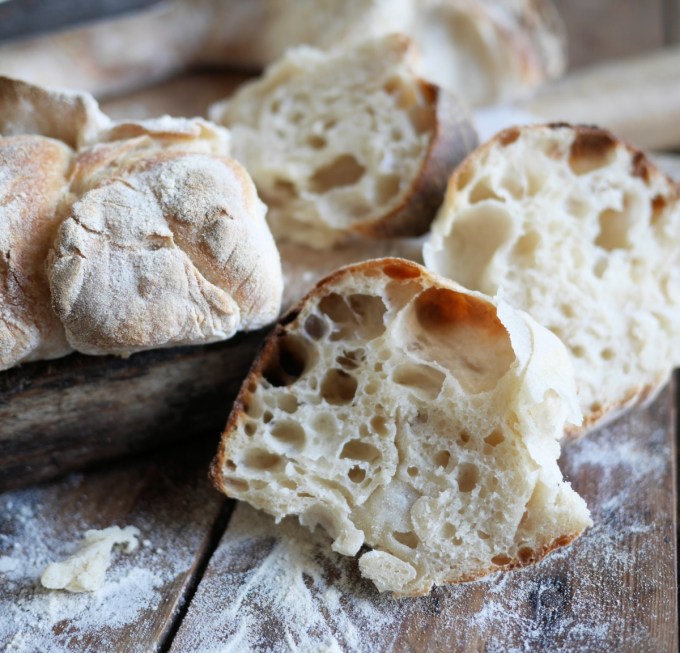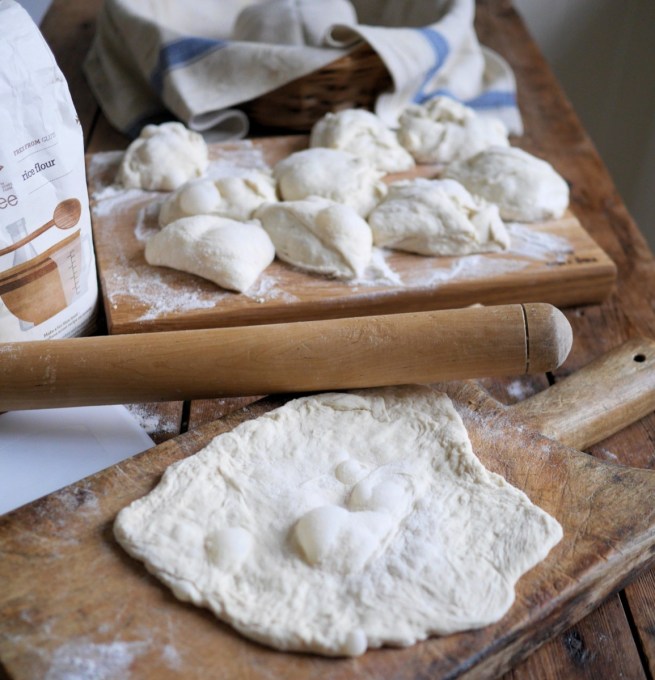Traditional Sourdough Couronne Bordelaise: A traditional bread from the area Bordeaux in SW France. This “Crown” bread is proved & shaped in a special “Couronne” banneton wicker basket. It’s a great shaped bread to serve for any buffet or cheeseboard, as a cheese, such as a boxed Camembert, can be placed in the middle.

A Great Sourdough Bread for Bread & Cheese!

I am an avid collector of what is called “Kitchenalia”, I suppose it comes with the territory of being a food writer and recipe developer. And, most of my vast collection comes from France, where I lived for over 18 years. I have all sorts of bric-a-brac for the kitchen and dining room…..oyster plates, old cutlery, bread boards, bread knives, vintage Le Creuset pans, vintage French (and English) crockery, enamel bowls, old coffee pots and a small collection of wicker Couronne Bannetons which hang on the wall. These lovely old baskets are used to shape and prove a classic French bread, Traditional Sourdough Couronne Bordelaise, the recipe of which I am sharing today.



A Traditional Sourdough Couronne Bordelaise is a bread that I’m used to enjoying, as we used to live just North of Bordeaux, where this bread hails from. Anything that is named “Bordelaise” means that it originates from the Bordeaux region in the Aquitaine, in SW France; and, a “Couronne” means a crown in French, which this bread emulates by being baked in a round with little rolls making up the crown shape. Our local bakery in Saint-André-de-Lidon used to sell the most amazing Traditional Sourdough Couronne Bordelaise bread, along with the usual suspects of baguettes, pain, batard, flutes, ficelle and pain d’epi.





However, as I now live in North Wales, I can’t just nip down to the boulangerie in the next village, so I decided to liberate one of my couronne bannetons, which was hanging on the dining room wall, to make my own Traditional Sourdough Couronne Bordelaise. The following recipe is made with a batch of my classic sourdough bread made easy dough, and although it isn’t hard to make a Traditional Sourdough Couronne Bordelaise, it does take some time, and it’s a little fiddly, but it is a thoroughly enjoyable and rewarding process all the same. I have shared some very simple step-by-step instructions below, with photos, to help you make one of these wonderful French loaves.



To follow the instructions below, you must have first made a batch of sourdough, and therefore I have added my recipe for Classic Sourdough Bread made Easy. Start the process off the day before you plan to shape and bake your Traditional Sourdough Couronne Bordelaise. Allow it to prove overnight, then at about 10:00 or 11:00 the following day, follow the step-by-step instructions below. It only needs another hour to prove (in a cold place) after shaping before baking. As it is a ring (or more precisely a crown!) of bread, it doesn’t take as long to bake as a large sourdough boule. The recipe and procedure is shared below, and PLEASE don’t hesitate to ask me if you have any queries. Happy baking, Karen
Disclaimer: [AD] The beautiful Mason Cash Terracotta Bread Baking Set that I used in my recipe and which is shown in the photos, was a gift from The Big Kitchen. I was not paid to share photos of this gift on my site or to create this recipe. RRP: £32:00



Step-by-Step Procedure to make
Traditional Sourdough Couronne Bordelaise:

You will need:
**12″ (30cm) wicker couronne banneton**
Large linen tea towel (if the banneton is not lined)
Large bowl for proving overnight
Shower cap or cling film to cover
Rice flour
Flexible dough scraper and cutter
12″ (30cm) pizza stone or baking stone
Baking paper
**If you don’t have a wicker couronne banneton, use a large bowl with a ramekin upturned in the middle, then drape it with a large tea towel to shape**
Recipe:
Classic Sourdough Bread made Easy

Step-by-Step Procedure:
-
After the basic sourdough has proved overnight, tip it out of the bowl onto a large floured board. Use rice flour and not wheat flour. (Place the linen tea towel inside the banneton if it’s not lined, and sprinkle rice flour over it)

-
Divide it into 10 equal pieces, using a flexible dough scraper to cut it. Be gentle and do not handle too much, as it will knock the “air bubbles” out of the dough.

-
Set 9 balls of dough to one side, and roll out the remaining ball into a large round, similar to the shape of a flat bread or pizza.

-
Place the rolled out dough over the raised hump in the middle of the banneton basket, easing it out evenly.

-
Arrange the remaining 9 balls of dough over the dough disc forming a circle of balls. With a pair of scissors or a razor blade, cut the centre of the disc so it has 9 points, then pull these back and fold them over each ball of dough. Cover with a shower cap or clingfilm and set aside in a cold place for 1 hour.

-
Pre-heat the oven to 230C/450F/Gas mark 8. Cut a circle of baking paper to fit the pizza or baking stone. Invert the banneton basket over the top of the lined pizza/baking stone, and ease the Couronne Bordelaise out.


-
Bake in pre-heated oven for 35 to 45 minutes, or until the Couronne Bordelaise is well risen, is light brown and sounds hollow when tapped underneath. Gently lift the Couronne Bordelaise off the pizza/baking stone onto a wire cooling rack, and allow to cool completely.

-
Enjoy! Especially with cheese, soup, stew, or as a sandwich.



Classic Sourdough Bread
| Serves | 1 x 500g sourdough loaf |
| Prep time | 18 hours, 30 minutes |
| Cook time | 1 hour |
| Total time | 19 hours, 30 minutes |
| Allergy | Wheat |
| Dietary | Vegan, Vegetarian |
| Meal type | Bread |
| Misc | Child Friendly, Freezable, Pre-preparable, Serve Cold |
| Occasion | Barbecue, Birthday Party, Casual Party, Christmas, Easter, Halloween |
| Region | British |
| By author | Karen Burns-Booth |
Ingredients
- 60g recently fed sourdough starter
- 5g teaspoon sea salt
- 320ml tepid filtered water (or boiled water)
- 500g strong white bread flour
- Rice flour (for dusting)
Note
My recipe for classic sourdough bread which is a winner every time I bake it; and it can be proved overnight in a cool place for early morning baking.
Directions
| Step 1 | 2 to 3 hours before you want to start your sourdough bread, take the starter out of the fridge and feed it with 40g filtered water and 40g strong white bread flour. Mix well, cover with cling film (or a shower cap) and set to one side to start working. After 2 to 3 hours the starter should be frothy and light with lots of bubbles and it may be making a noise, as in singing! It's now ready to use. Put the covered starter back in the fridge until it is needed next time you want to bake. |
| Step 2 | Place a bowl onto some digital scales and set the tare to zero. Add 60g of sourdough starter and set the tare to zero again; then add the salt and water, again, I find it easier to set the tare to zero before adding the flour. Take the bowl off the scales and mix well, it will look rough and lumpy, but never fear it will soon start to look like bread dough! Cover the dough with cling film/shower cap and set to one side. |
| Step 3 | After an hour, uncover it and with your hands, bring the dough from the outside, and fold it into the middle. Do this for about 15 to 20 times - I find it is easier if I rotate the bowl at the same time. Cover it and set to one side. |
| Step 4 | Do the folding and turning action two or three more times over the next few hours, by this time the dough will be smooth, elastic and sticky. I start this at about 3pm to 4pm and the dough is ready at about 8pm to 9pm. |
| Step 5 | Once the dough is smooth and elastic (see above) and it will have risen by now too, take a 22cm (9") to 24cm (10") banetton basket and dust it with rice flour. Do one more set of folding actions with the dough and then place the ball of dough into the floured banneton basket. Easing the dough up around the sides, sprinkle some more flour around it and then sprinkle some over the top of of the dough. Cover with cling film/shower cap and set to one side in a cool place to prove overnight. (I use my pantry which is about 14 degrees C) |
| Step 6 | In the morning, the dough will have risen overnight and you will have a large, round ball of smooth dough that's ready to bake. Pre-heat the oven to 230C/220C Fan/450F/425F Fan/Gas mark 8 and line a large 30cm (15") cast iron casserole dish (Dutch oven) that has a lid, with grease-proof baking paper. |
| Step 7 | Uncover and invert the dough into the cast iron pot and then score the top with a lame or a razor blade. Place the lid on the pot and bake in the pre-heated oven for 50 minutes until the bread is well-risen, golden brown and with a crisp crust. NB: if you want a darker crust, take the lid off and bake for a further 5 to 10 minutes. |
| Step 8 | Carefully turn the loaf out onto a wire cooling rack and allow to cool for 1 hour before slicing it. Store it in the cooled cooking pot. |
| Step 9 | NOTE: I have recently experimented with the cold oven method, and it works like a dream. At step 7, place the bread into the pot and into a cold oven, then set the temperature for 230C/450F/Gas mark 8 and bake for 1 hour. Again, if you want a darker crust, take the lid off and bake for a further 5 to 10 minutes extra. |
PIN IT!

PIN MORE!





 Print recipe
Print recipe






mohan kumar says
they all looked really fabulous.thanks for sharing
Mara says
This reminds me of my granny, it’s so cool! I’m also struggling for a healthier me, I’ve even start running with SportMe and I can say I’m on the right track now. Nutrition is an important part of my losing weight plan, and your blog posts are a true inspiration!
Francesca says
Hi there! My dad bought me a couronne banneton not knowing what it was for so now I am tasked with using it! I would love to give this a go but I don’t have the baking stone. Is there a way of doing this without it?
Thank you!
Francesca
Karen Burns-Booth says
Hi there!
That’s a fabulous present 🙂
You can bake this on any pre-heated baking tray, I hope that helps.
Karen
Zach says
Do you do any shaping on the nine dough balls? Or are they placed in the proofing vessel just as cut dough blobs?
Karen Burns-Booth says
Hi Zach – you roll them into small balls. Karen
Lakshmi stores says
Excited to try it out!